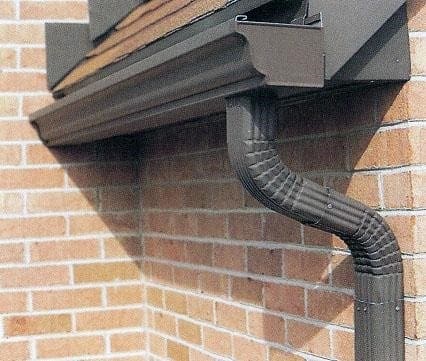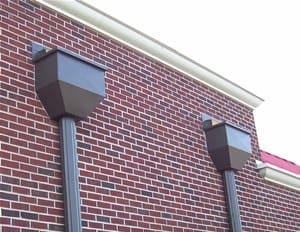Designing a Flat Roof Drainage System Engineering Specs
It's important that the roof drainage system on your next commercial building is properly designed. Buildup of rainwater on a roof can cause structural damage and leaks. Improper gutter drainage can cause erosion of soils and foundation issues. It is important for architects, plumbing engineers, and civil engineers to work together to design a system that will properly drain rainwater from a building and site.
Roof Drain Systems
A typical commercial or multifamily residential building will utilize one of the following types of primary roof drainage:
Internal roof drains
These will drain to somewhere near the center of the roof and down through the building to underground storm mains or a detention pond. This form of roof drainage is preferred if a clean exterior appearance is desired. The roof is sloped towards the drain through either tapered insulation or through joist modifications below the roofline.

External downspouts/gutters
These will drain to the exterior of the building with downspouts and ultimately discharge at grade to sheet flow, or to be hard-piped to an underground storm system or detention pond. This form of drainage is preferred to prevent water from pooling on the roof and keeps rainwater from being routed through the building.

Environmentally friendly properties may consider utilizing storm water re-use through collection for irrigation and/or toilet use. This is not as common as traditional drainage systems, mainly due to the high up-front cost of these systems.
Sizing of Systems
Typical roof drainage is sized at a rainfall rate that relates to a 100-year event. In Austin, this is laid out as approximately 4" per hour; however, in the City there is an amendment that requires the utilization of 5" per hour. (If you are not located in Austin, these rates and code requirements may vary.)
Primary drains should be sized according to UPC storm tables at a rainfall rate of 5" per hour. Note that roof drain bodies and vertical conductors are sized utilizing a different table that a horizontally sloped storm line. Different horizontal sloping will offer different drainage capacities. Code tables outline pipe slopes of: 1/8", 1/4" and 1/2" per foot. Pipe sizing is listed as amount of square foot roof areas served by the drains.
Secondary Drainage
Secondary (or emergency) roof drainage is required wherever the buildup of water is detrimental to the roof structure. Secondary drainage shall be provided through the use of sidewall scuppers or internal roof drains. In either case, the discharge shall be located so that it is readily visible by building occupants.

If discharge is witnessed, it's a telltale sign that the primary roof drain may be clogged. The UPC also allows for secondary and primary drainage to be combined, provided the rainfall rate utilized is doubled and that the secondary drainage ties into the primary drain downstream of the last horizontal offset.
Need an engineering expert that will ensure that your commercial building drains properly? Contact us today to get in touch with our MEP Engineering experts!
Designing a Flat Roof Drainage System Engineering Specs
Source: https://wginc.com/roof-drainage-system-design/